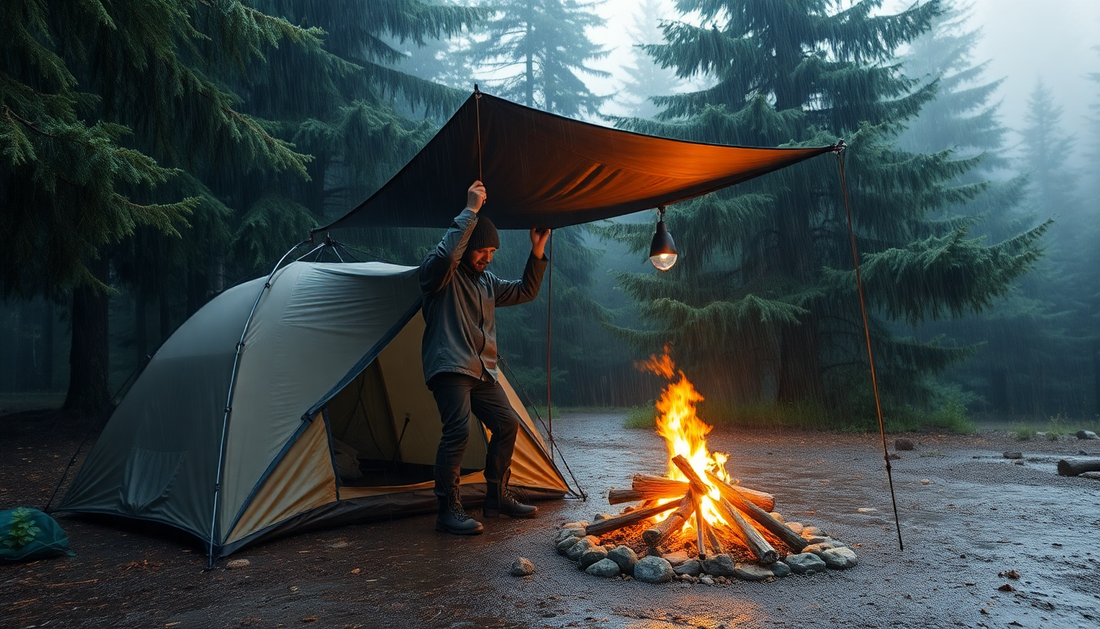
How to Stay Warm and Dry While Camping in Bad Weather
As the chill of winter sets in and the rain begins to pour, many outdoor enthusiasts find themselves hesitant to venture out into the wilderness. However, with the right preparation and knowledge, camping in inclement weather can be a truly rewarding experience. In this comprehensive guide, we'll explore the strategies and gear essential for staying warm and dry while camping in bad weather, empowering you to embrace the elements and make the most of your next outdoor adventure.
Understanding the Challenges of Bad Weather Camping
Camping in bad weather can present a unique set of challenges, from dealing with the physical discomfort of cold and wet conditions to the potential risks to your safety and well-being. Whether you're facing heavy rain, biting winds, or unexpected snowfall, it's crucial to understand the impact these elements can have on your camping experience.
The Importance of Staying Warm
Maintaining a comfortable body temperature is essential for both your physical and mental well-being while camping. Exposure to cold, wet conditions can lead to hypothermia, a dangerous condition that can quickly become life-threatening. By prioritizing warmth, you'll not only ensure your safety but also enhance your overall enjoyment of the outdoors.
The Necessity of Staying Dry
Keeping your body and gear dry is another critical aspect of bad weather camping. Wet clothing and equipment can lead to a host of problems, from increased risk of hypothermia to the discomfort of sleeping in a damp sleeping bag. Mastering the art of staying dry is key to a successful and enjoyable camping trip in inclement weather.
The Challenges of Shelter and Campsite Selection
Choosing the right campsite and setting up an effective shelter can be particularly challenging in bad weather. Factors such as wind direction, drainage, and proximity to natural shelters become increasingly important when dealing with rain, snow, or strong gusts.
Preparing for Bad Weather Camping
Successful bad weather camping starts with thorough preparation. By anticipating the challenges and equipping yourself with the right gear and knowledge, you can ensure a safe and comfortable experience, even in the face of Mother Nature's most unforgiving conditions.
Choosing the Right Gear
Investing in high-quality, weather-resistant gear is essential for staying warm and dry while camping in bad weather. This includes selecting the appropriate clothing, shelter, and camping equipment to meet the specific demands of the conditions you'll be facing.
Clothing Considerations
Layering is the key to maintaining body temperature in cold, wet conditions. Look for moisture-wicking base layers, insulating mid-layers, and weatherproof outer shells. Ensure that your socks, gloves, and headwear are also designed to keep you warm and dry.
Shelter Selection
When it comes to shelter, choose a tent or tarp that is specifically designed to withstand heavy rain, wind, and snow. Look for features like waterproof fabrics, sturdy poles, and effective ventilation to keep you protected from the elements.
Camping Equipment
Your camping equipment, from your sleeping bag to your cooking gear, should be selected with bad weather in mind. Opt for insulated, water-resistant options that will maintain their performance even in the harshest conditions.
Mastering Campsite Selection
Choosing the right campsite can make a significant difference in your ability to stay warm and dry. Look for sheltered areas, such as those near natural windbreaks or under the canopy of trees, and avoid low-lying areas prone to flooding or pooling water.
Developing Essential Skills
In addition to having the right gear, it's crucial to develop the skills necessary for camping in bad weather. This includes techniques for setting up your shelter effectively, managing your campfire, and properly caring for your equipment to ensure its longevity.
Strategies for Staying Warm and Dry
With the right preparation and mindset, you can thrive in even the most challenging weather conditions. By employing a combination of practical techniques and innovative solutions, you can maintain your comfort and safety while enjoying the great outdoors.
Layering for Warmth
Effective layering is the foundation of staying warm in bad weather. Start with a moisture-wicking base layer, add an insulating mid-layer, and top it off with a weatherproof outer shell. Ensure that your layers work together to trap heat while allowing for breathability.
Staying Dry
Keeping your body and gear dry is crucial for maintaining warmth and preventing the onset of hypothermia. Invest in high-quality, waterproof outerwear, and use techniques like proper tent setup and gear storage to minimize moisture exposure.
Campfire Management
A well-managed campfire can be a powerful tool for staying warm and dry while camping in bad weather. Learn how to build and maintain a fire that can withstand the elements, providing both heat and a means of drying your gear.
Insulating Your Sleeping Area
Your sleeping setup is a critical component of staying warm and comfortable in bad weather. Choose an insulated sleeping bag rated for the expected temperatures, and consider using a sleeping pad or ground cloth to create a barrier between you and the cold, damp ground.
Hydration and Nutrition
Maintaining proper hydration and nutrition is essential for keeping your body functioning at its best in challenging weather conditions. Ensure that you have access to warm, nourishing meals and plenty of fluids to fuel your body and support your immune system.
Embracing the Elements
Camping in bad weather may present unique challenges, but with the right mindset and preparation, it can be a truly rewarding experience. By embracing the elements and leveraging the strategies outlined in this guide, you can unlock a deeper connection with the natural world and create lasting memories of your outdoor adventures.
Remember, the key to successful bad weather camping lies in your willingness to adapt, your commitment to safety, and your passion for the great outdoors. So, the next time the forecast calls for rain, snow, or wind, don't let it deter you – instead, embrace the opportunity to test your skills and deepen your appreciation for the beauty and power of nature.







